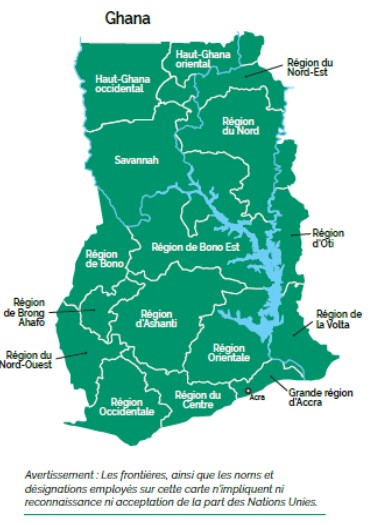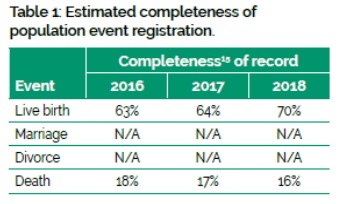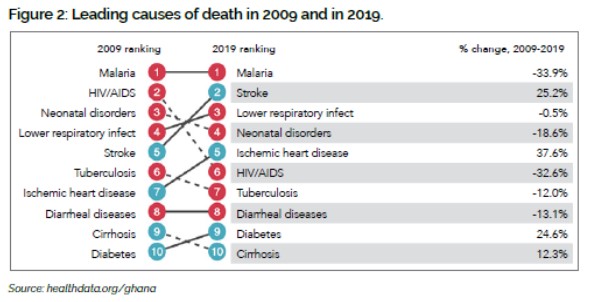Introduction
The purpose of this report is to provide a brief introduction to the civil registration and vital statistics (CRVS) system in Ghana.
The information was collected through a questionnaire completed by the civil registration services in January 2020 and supplemented by a desk review of available documents. Among other things, the report presents:
- Background information on the country;
- Selected indicators relevant for CRVS improvement processes;
- Stakeholders’ activities; and
- Resources available to strengthen CRVS systems.

Disclaimer: The boundaries and names shown and the designations used on this map do not imply official endorsement or acceptance by the United Nations.
Country profile
The Republic of Ghana is located along the Gulf of Guinea and the Atlantic Ocean, in the subregion of West Africa. Ghana is bordered by Côte d’Ivoire to the west, Burkina Faso to the north, Togo to the east, and the Gulf of Guinea and the Atlantic Ocean to the south.
Ghana is divided into 16 administrative regions and subdivided into 275 districts.
238,535
30,000,000
2.2
CRVS Dimensions
Birth
| Completeness of birth registration |
Not available |
| Children under 5 whose births were registered |
71% (2014 |
| Births attended by skilled health professionals |
78% (2014 |
| Women aged 15-49 who received antenatal care from a skilled provider |
87% (2014 ) |
| DPT1 immunization coverage among 1-year-olds |
96% 2016 |
| Crude birth rate (per 1,000 population) |
29.85 (2017 |
| Total fertility rate (live births per woman) |
3.9 (2018 |
| Adolescent fertility rate (per 1,000 girls aged 15-19 years) |
67 (2018 |
| Population under age 15 |
29% (2017 |
Death
| Completeness of death registration |
Not available (N/A) |
| Crude death rate (per 1,000 population) |
7.41 (2017 ) |
| Infant mortality rate (probability of dying by age 1 per 1,000 live births) |
34.91 (2018 |
| Under five mortality rate (probability of dying by age 5 per 1,000 live births) |
47.9 (2017 |
| Maternal mortality ratio (per 100,000 live births) |
320 (2015 |
Marriages and divorces
| Marriage registration rate |
Not available |
| Women aged 20-24 first married or in union before age 15 |
Not available (N/A) |
| Women aged 20-24 first married or in union before age 18 |
Not available (N/A) |
| Divorce registration rate |
Not available |
Vital statistics including causes of death data
| Compilation and dissemination of CR-based statistics |
Not available (N/A) |
| Medically certified causes of death data |
Not available (N/A) |
Civil registration system
Legislative Framework
The laws governing civil registration in Ghana include the Registration of Births and Deaths Act, 1965 (Act 301).
Vital events indicated in legislation include birth, death, marriage, divorce, and adoption, covering all legal geographic areas of Ghana and its entire population, including non-citizens and refugees, with provisions for the collection of vital statistics.
Management, organization and operations
The demographic events that are currently covered by the civil registration system include live birth, death, marriage, divorce, and adoption, although synchronization of definitions with the definitions suggested by the United Nations is only done for live births and deaths so far.
National CRVS systems coordination mechanisms
There is a national coordination mechanism in place that provides a forum for stakeholders in CRVS systems. The coordination committee is made up of members from the following institutions:
- Births and Deaths Registry;
- Ghana Health Service;
- Ghana Statistical Service; and
- National Identification Authority.
There is no law or other instrument (such as a memorandum of understanding or terms of reference) for the establishment and functioning of the coordinating committee.
Administrative level registration centres
The lowest administrative level is the community level.
Accessibility of civil registration services
Accessibility of local civil registration offices in Ghana still remains a challenge, with little information available on the number of service points, local civil registration offices, and local registrars countrywide.
Registration of vital events
Civil registration and vital statistics physical documents are prepared separately. Vital statistics records are prepared separately.
The categories of registers are:
- A register of births;
- A marriage register;
- A register of deaths; and
- A register of miscellaneous acts (life certificate, residence certificate, certificate of non-remarriage, etc.).
Recording of demographic events currently covers all segments of the country’s population and all geographical regions of the country. The estimated completeness of event registration is shown in Table 1

Backlog of unregistered births
The country has a backlog
Vital statistics system
Vital statistics
Ghana Statistical Service has the legal mandate for the collection, compilation, analysis, publication, and dissemination of vital statistics and the coordination of the national statistical system. Ghana Statistical Service also collects statistics on causes of death.
Vital statistics on live births and deaths are compiled from the civil registration system and vital statistics reports are published.
Causes of death
In Ghana, the cause-of-death information is collected through the civil registration system, especially for institutional deaths (Table 2).
For non-institutional deaths, verbal autopsy tools or methods are used for collecting cause-of death information and the cause of death is coded according to the International Classification of Diseases version 10 (ICD-10). However, no report on the causes of death has been published.


Other sources indicate the infant mortality rate at 36.11 deaths per 1,000 live births in 2017 (Figure 1).

Digitization
Computerization
Ghana, through the e-government strategy called eGhana, has created an enabling environment through the e-government network infrastructure, the data centre, and server infrastructure, and has established the e-services portal.
The transfer of vital statistics data from the civil registration system to the office responsible for compiling vital statistics is done electronically.
Online registration services at health facilities
The health sector under the Ghana Health Service is mandated to notify all births and deaths, using the institutional forms provided by the Births and Deaths Registry. Current institutional deliveries in health facilities are at 73 percent and births attended by skilled health staff were reported at 78 percent of the total in 2017, according to UNICEF.
Mobile technology application
Mobile technology is employed in the notification of occurrence of vital events.
Unique identification number
There is an existing identification (ID) system, which is linked to the civil registration system. The ID is issued by the National Identification Authority (NIA) under the Office of the President. To acquire a national ID, applicants must submit one of the following documents: birth certificate, marriage certificate, or citizenship certificate. National ID enrolment is mandatory for all residents of Ghana over 15 years of age, regardless of citizenship status.
In 2006, Act 707 established the NIA as the sole authority responsible for the enrolment of individuals in the program and for the issuance of national identity cards. The NIA is also required to establish a biometric-based national identity register. Sections 18 and 73 of Acts 707 and 750, respectively, state that NIA will craft regulations to create, maintain, provide, and promote the use of national identity cards.
There is a data protection law in place. Under Ghana’s Data Protection Act of 2012 (Act 843), a data protection commission was set up and functions as an independent statutory body to protect the privacy of the individual and personal data by regulating the processing of personal information. The commission is responsible for the process to obtain, hold, use, or disclose personal information, and for other issues related to the protection of personal data.
Population register
Digitization of historical registration records
There are ongoing efforts by the Births and Deaths Registry to digitize manual historical registration records.
Link with identification system
The existing ID system is linked to the civil registration system. In the current institutional arrangement between ID and civil registration, apart from consultation frameworks, there are currently no formalized functional relationships.
Sample registration forms
Improvement initiatives and external support
Improvement plan and budget
Strategic plan
There is no national CRVS improvement strategic plan so far in Ghana. However, a comprehensive assessment of the CRVS systems in Ghana was undertaken in 2015.
Budgetary allocations and requirements
In fiscal year 2020–2021, the budget allocated by the State Treasury to the civil registration system is not provided. No specific amount is indicated from development partners providing in-kind or other support.
Activities identified as high priorities
No activities are identified in the national plan as high priorities for lack of funding. Some of the upcoming priorities in the country’s planning cycle for the civil registration office include:
- Increasing the number of service delivery centres;
- Deploying technology in the collection and processing of vital events, including e-services, e-payments, and shipments;
- Increasing mobility; and
- Strengthening collaborations with CRVS stakeholders.
Support from development partners
The international organizations, non-governmental organizations, and other organizations that support the improvement of the civil registration system in the country that are not part of the government administration in Ghana are listed in Table 3

In addition, the Secretariat of the Africa Programme on Accelerated Improvement of Civil Registration and Vital Statistics (APAI-CRVS) and its partners support the Ghana civil registration system through
- capacity building;
- seminars and workshops on emerging trends (such as issues with surrogacy, which is becoming common in African countries); and
- advocating for governments to invest adequately in CRVS.
Additional Materials
Websites
Additional materials
Ghana e-Government Interoperability Framework. ghanahealthservice.org/downloads/Ghana_eGIF_Main.pdf
Ghana Statistical Service. 2015. Civil Registration and Vital Statistics System in Ghana: Report on the Comprehensive Assessment. statsghana.gov.gh/docfiles/publications/CRVS%20Assessment%20Report%20Final_%2018.04.17.pdf
Government of Ghana. 1965. Registration of Births and Deaths Act. Laws of Ghana. refworld.org/docid/548edaf74.html
Conclusion
The CRVS systems in Ghana are multisectoral due to the different agencies being responsible for different vital events, hence the need for proper and functional coordination mechanisms. This will provide a proper understanding of the business processes for the different stakeholders, align the priorities, and ensure a harmonized approach to different CRVS initiatives. High-level commitments have been made to improving civil registration and vital statistics.
Some of the key lessons to learn from Ghana include the following:
- The Ghana Health Service is used for notification of vital events occurring in health facilities.
- There is a Data Protection Act of 2012 (Act 843) in place and a data protection commission functions as an independent statutory body to protect the privacy of the individual and personal data by regulating the processing of personal information.
The current priorities for CRVS in Ghana include increasing service delivery, deploying technology, and strengthening the coordination between the different stakeholders.
Endnotes
[footnotes]